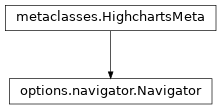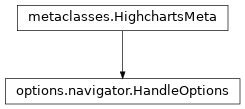.navigator
class: Navigator
- class Navigator(**kwargs)[source]
The navigator is a small series below the main series, displaying a view of the entire data set. It provides tools to zoom in and out on parts of the data as well as panning across the dataset.
Class Inheritance

- copy(other=None, overwrite=True, **kwargs)
Copy the configuration settings from this instance to the
otherinstance.- Parameters:
other (
HighchartsMeta) – The target instance to which the properties of this instance should be copied. IfNone, will create a new instance and populate it with properties copied fromself. Defaults toNone.overwrite (
bool) – ifTrue, properties inotherthat are already set will be overwritten by their counterparts inself. Defaults toTrue.kwargs – Additional keyword arguments. Some special descendents of
HighchartsMetamay have special implementations of this method which rely on additional keyword arguments.
- Returns:
A mutated version of
otherwith new property values
- classmethod from_dict(as_dict: dict, allow_snake_case: bool = True)
Construct an instance of the class from a
dictobject.
- classmethod from_js_literal(as_str_or_file, allow_snake_case: bool = True, _break_loop_on_failure: bool = False)
Return a Python object representation of a Highcharts JavaScript object literal.
- Parameters:
as_str_or_file (
str) – The JavaScript object literal, represented either as astror as a filename which contains the JS object literal.allow_snake_case (
bool) – IfTrue, interpretssnake_casekeys as equivalent tocamelCasekeys. Defaults toTrue._break_loop_on_failure (
bool) – IfTrue, will break any looping operations in the event of a failure. Otherwise, will attempt to repair the failure. Defaults toFalse.
- Returns:
A Python object representation of the Highcharts JavaScript object literal.
- Return type:
HighchartsMeta
- classmethod from_json(as_json_or_file, allow_snake_case: bool = True)
Construct an instance of the class from a JSON string.
- Parameters:
as_json_or_file – The JSON string for the object or the filename of a file that contains the JSON string.
allow_snake_case (
bool) – IfTrue, interpretssnake_casekeys as equivalent tocamelCasekeys. Defaults toTrue.
- Returns:
A Python objcet representation of
as_json.- Return type:
HighchartsMeta
- get_required_modules(include_extension=False) → List[str]
Return the list of URLs from which the Highcharts JavaScript modules needed to render the chart can be retrieved.
- to_dict() → dict
Generate a
dictrepresentation of the object compatible with the Highcharts JavaScript library.Note
The
dictrepresentation has a property structure and naming convention that is intentionally consistent with the Highcharts JavaScript library. This is not Pythonic, but it makes managing the interplay between the two languages much, much simpler.
- to_js_literal(filename=None, encoding='utf-8') → str | None
Return the object represented as a
strcontaining the JavaScript object literal.
- to_json(filename=None, encoding='utf-8')
Generate a JSON string/byte string representation of the object compatible with the Highcharts JavaScript library.
Note
This method will either return a standard
stror abytesobject depending on the JSON serialization library you are using. For example, if your environment has orjson, the result will be abytesrepresentation of the string.- Parameters:
- Returns:
A JSON representation of the object compatible with the Highcharts library.
- Return type:
- static trim_dict(untrimmed: dict, to_json: bool = False) → dict
Remove keys from
untrimmedwhose values areNoneand convert values that have.to_dict()methods.
- static trim_iterable(untrimmed, to_json=False)
Convert any
EnforcedNullTypevalues inuntrimmedto'null'.
- property adapt_to_updated_data: bool | None
If
True, the navigator and scroll will adapt to updated data in the base X-axis. Defaults toNone, which behaves asFalse.Hint
When loading data asynchronously, this should be
False. Otherwise new data will trigger the navigator to redraw, which will cause unwanted looping.
- property enabled: bool | None
If
True, enables the navigator. ifFalse, disables it. Defaults toNone, which behaves asTrue.
- property handles: HandleOptions | None
Options for the handles that allow dragging the zoomed-in area. Defaults to
None.- Return type:
- property height: int | float | Decimal | None
The height given to the navigator, expressed in pixels. Defaults to
40.- Return type:
numeric or
None
- property margin: int | float | Decimal | None
The distance from the nearest element (either the X-axis or the X-axis labels), expressed in pixels. Defaults to
25.- Return type:
numeric or
None
- property mask_fill: str | Gradient | Pattern | None
The color of the mask covering the areas of the navigator series that are currently not visible in the main series. Defaults to
'rgba(102,103,194,0.3)', which is bluish and slightly transparent to see the series below.
- property mask_inside: bool | None
If
True, renders the mask inside the range marking the zoomed-in data. IfFalse, renders the mask outside the zoomed-in data range. Defaults toNone, which behaves asTrue.
- property opposite: bool | None
If
True, renders the navigator on the opposite side when the chart is inverted. Defaults toNone, which behaves asFalse.
- property outline_color: str | Gradient | Pattern | None
The color of the line marking the currently zoomed area in the navigator. Defaults to
'#cccccc'.
- property outline_width: int | float | Decimal | None
The width of the line marking the currently zoomed-in area of the navigator. Defaults to
1.- Return type:
numeric or
None
- property series
Options for the navigator series (the series of data drawn in the navigator). Defaults to
None, which is equivalent to:series = AreaSplineSeries( fill_opacity = 0.05, data_grouping = DataGrouping(smoothed = True), line_width = 1, marker = Marker(enabled = False) )
Hint
If the
seriessetting does not havedataexplicitly provided, it will default to thedataof the first series in the chart.- Return type:
SeriesBaseorNone
- property x_axis: XAxis | None
Configuration of the navigator’s X-axis. Defaults to
None, which implicitly applies the following:x_axis = XAxis( tick_width = 0, line_width = 0, grid_line_width = 1, tick_pixel_interval = 200, labels = AxisLabelOptions(align = left, style = { 'color': '#888' }, x = 3, y = -4) )
- Return type:
XAxisorNone
- property y_axis: YAxis | None
Configuration of the navigator’s X-axis. Defaults to
None, which implicitly applies the following:y_axis = YAxis( grid_line_width = 0, start_on_tick = False, end_on_tick = False, min_padding = 0.1, max_padding = 0.1 labels = AxisLabelOptions(enabled = False), title = AxisTitle(text = None), tick_width = 0 )
- Return type:
YAxisorNone
class: HandleOptions
- class HandleOptions(**kwargs)[source]
Options for the handles that allow dragging the zoomed-in area.
Class Inheritance

- copy(other=None, overwrite=True, **kwargs)
Copy the configuration settings from this instance to the
otherinstance.- Parameters:
other (
HighchartsMeta) – The target instance to which the properties of this instance should be copied. IfNone, will create a new instance and populate it with properties copied fromself. Defaults toNone.overwrite (
bool) – ifTrue, properties inotherthat are already set will be overwritten by their counterparts inself. Defaults toTrue.kwargs – Additional keyword arguments. Some special descendents of
HighchartsMetamay have special implementations of this method which rely on additional keyword arguments.
- Returns:
A mutated version of
otherwith new property values
- classmethod from_dict(as_dict: dict, allow_snake_case: bool = True)
Construct an instance of the class from a
dictobject.
- classmethod from_js_literal(as_str_or_file, allow_snake_case: bool = True, _break_loop_on_failure: bool = False)
Return a Python object representation of a Highcharts JavaScript object literal.
- Parameters:
as_str_or_file (
str) – The JavaScript object literal, represented either as astror as a filename which contains the JS object literal.allow_snake_case (
bool) – IfTrue, interpretssnake_casekeys as equivalent tocamelCasekeys. Defaults toTrue._break_loop_on_failure (
bool) – IfTrue, will break any looping operations in the event of a failure. Otherwise, will attempt to repair the failure. Defaults toFalse.
- Returns:
A Python object representation of the Highcharts JavaScript object literal.
- Return type:
HighchartsMeta
- classmethod from_json(as_json_or_file, allow_snake_case: bool = True)
Construct an instance of the class from a JSON string.
- Parameters:
as_json_or_file – The JSON string for the object or the filename of a file that contains the JSON string.
allow_snake_case (
bool) – IfTrue, interpretssnake_casekeys as equivalent tocamelCasekeys. Defaults toTrue.
- Returns:
A Python objcet representation of
as_json.- Return type:
HighchartsMeta
- get_required_modules(include_extension=False) → List[str]
Return the list of URLs from which the Highcharts JavaScript modules needed to render the chart can be retrieved.
- to_dict() → dict
Generate a
dictrepresentation of the object compatible with the Highcharts JavaScript library.Note
The
dictrepresentation has a property structure and naming convention that is intentionally consistent with the Highcharts JavaScript library. This is not Pythonic, but it makes managing the interplay between the two languages much, much simpler.
- to_js_literal(filename=None, encoding='utf-8') → str | None
Return the object represented as a
strcontaining the JavaScript object literal.
- to_json(filename=None, encoding='utf-8')
Generate a JSON string/byte string representation of the object compatible with the Highcharts JavaScript library.
Note
This method will either return a standard
stror abytesobject depending on the JSON serialization library you are using. For example, if your environment has orjson, the result will be abytesrepresentation of the string.- Parameters:
- Returns:
A JSON representation of the object compatible with the Highcharts library.
- Return type:
- static trim_dict(untrimmed: dict, to_json: bool = False) → dict
Remove keys from
untrimmedwhose values areNoneand convert values that have.to_dict()methods.
- static trim_iterable(untrimmed, to_json=False)
Convert any
EnforcedNullTypevalues inuntrimmedto'null'.
- property background_color: str | Gradient | Pattern | None
The background color or gradient for the pane. Defaults to
'#f2f2f2'.
- property border_color: str | Gradient | Pattern | None
The color of the pane border. Defaults to
'#999999'.
- property enabled: bool | None
If
True, enables the handles. ifFalse, disables them. Defaults toNone, which behaves asTrue.
- property height: int | float | Decimal | None
The height given to the handles, expressed in pixels. Defaults to
15.- Return type:
numeric or
None
- property line_width: int | float | Decimal | None
The width of the handle border and the stripes inside, expressed in pixels. Defaults to
1.- Return type:
numeric or
None
- property symbols: List[str] | None
Configuration of the shapes given to the handles. Defaults to
None, which applies['navigator-handle', 'navigator-handle'].Note
The
symbolssetting takes a 2-member collection ofstrvalues. These values can either indicate CSS styles (as in the default behavior), aurl(...)to a graphic image, or the name of a (JavaScript)SVGRenderer.prototype.symbolscallback method.